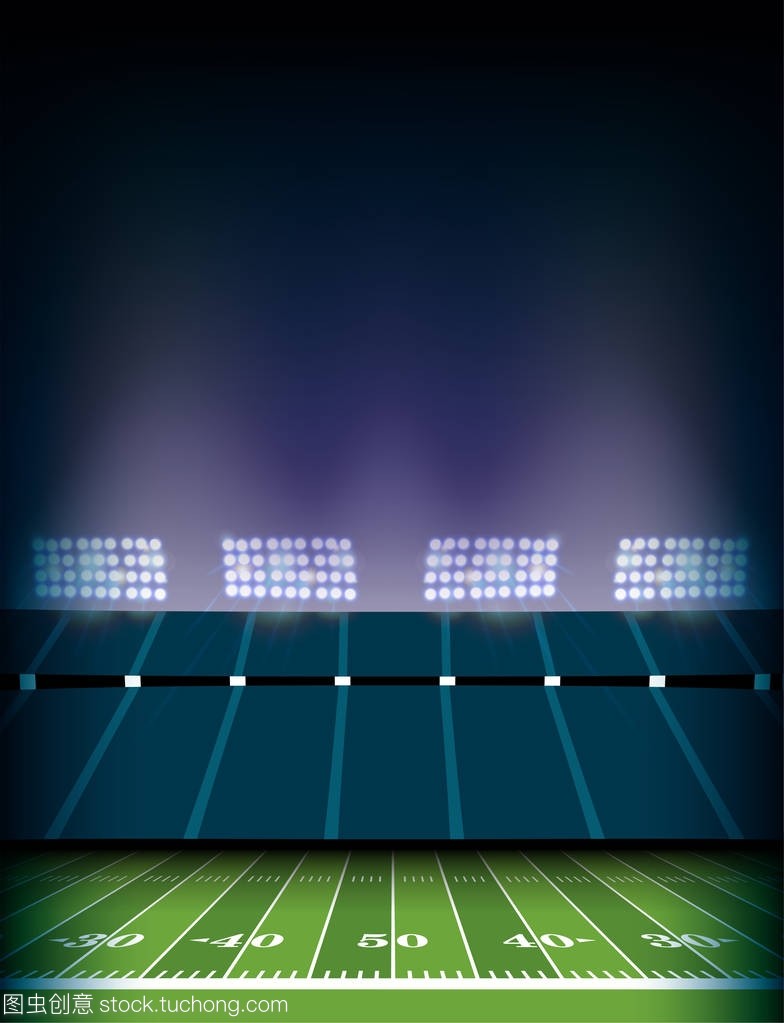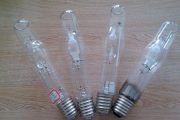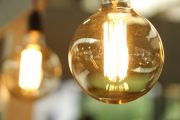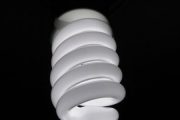1 What is Metal Halide lamp?
A metal-halide lamp is an electrical lamp that produces light by an electric arc through a gaseous mixture of vaporized mercury and metal halides (compounds of metals with bromine or iodine). It is a type of high-intensity discharge (HID) gas discharge lamp.
The lamps consist of a small fused quartz or ceramic arc tube which contains the gases and the arc, enclosed inside a larger glass bulb which has a coating to filter out the ultraviolet light produced. They operate at a pressure between 4 and 20 atmospheres, and require special fixtures to operate safely, as well as an electrical ballast. Metal atoms produce most of the light output. They require a warm-up period of several minutes to reach full light output.
2 Why replace Metal halide with LEDs?
 Metal halide lights have the longest warm-up period of any light on the market. Many metal halide lamps used in warehouses and sports facilities take 15-20 minutes just to reach their normal operating temperature. This is a major issue for several reasons:
Metal halide lights have the longest warm-up period of any light on the market. Many metal halide lamps used in warehouses and sports facilities take 15-20 minutes just to reach their normal operating temperature. This is a major issue for several reasons:
- They must be operated for longer periods of time than an LED because they do not switch on and off on demand.
- You must anticipate when you need light.
- Lights might be operated when they don’t have to be (for example during a 30 minute down period) to prevent them from needing the warm-up when turned back on.
Metal halide lights get less efficient when run at less than full operating power. The average bulb lasts around 6,000 to 15,000 operating hours. Depending on the particular bulb, you might spend around the same amount initially with LEDs and metal halides. The problem is that over time you will have to purchase a whole lot of metal halides (2-5) to equal the lifespan of a single LED. Overall that means very high maintenance costs over time.
3 Where are Metal Halide Lights Commonly Used?
Common applications for metal halide lighting includes large sport facilities like stadiums or hockey rinks as well as high bay lighting for warehouses and large indoor spaces.
Some metal halide lamps have long warm-up periods (15-20 minutes) when the light is first turned on or in the event that the power source is interrupted. Additionally, there is a small risk that a metal halide lamp can explode. Although this is rare and there are preventive measures that reduce risk, there is still the possibility of injury or damage as a result. Typical preventive measures include changing bulbs prior to their expected end of life and as a group (versus spot changing single bulbs that actually fail). This can significantly increase costs and significantly shorten the useful lifespan of the light.
Additionally, metal halide bulbs are inefficient energy consumers. On top of this, they need to be run for much longer periods of time than actually needed due to the warm-up requirement. This all translates to cost (generally manifested as a higher utility bill). Although they cost about the same as LEDs, metal halide bulbs will keep adding expenses over time based on the inefficient way in which they operate and the frequency with which they must be replaced. In a large-scale building (like a warehouse, hockey rink, or stadium), this inefficiency will really add up.
4 Main Advantages of LED lights:
Sturdiness
LEDs are solid express lighting devices that utilize semiconductor material rather than a filament or neon gas. An LED light is a tiny chip exemplified in an epoxy plant enclosure, which makes LEDs far sturdier than traditional incandescent bulbs or neon tubes.
Longevity
LEDs have a lifespan of up to 60,000 hours as opposed to 1,500 hours typical of incandescent bulbs. A great LED light can last over 7 years of constant use before needing a replacement. Usually, LED bulbs last ten times as long as small fluorescent bulbs and 133 times longer than typical incandescent bulbs. The long lifetime of LEDs will drastically reduce maintenance costs and lower long-term operating costs compared to traditional amoureux and fluorescent lights.
Safety
Superior safety may be the most significant benefit of LEDs. LED lamps generate almost no warmth therefore they are cool to the touch and can be left on for hours without incident or consequence if touched. LEDs produce 3.4 btu’s/hour compared to 85 for incandescent bulbs. In contrast, amoureux lighting expels 90% of the energy it utilizes via heat, making the bulbs hot to the touch. LEDs reduce the potential for safety dangers, such as burns and fires.
Efficiency
LEDs are packed powerfully with sufficient energy and use up to 90% less power than incandescent light bulbs. Since LEDs use cheaper energy than an incandescent bulb, there is a dramatic decrease in power costs, and thus, the money you dish out every month towards your utility bills. Money and energy are saved in maintenance and replacement costs due to the long LED life expectancy.
Environment
LEDs are made of non-toxic materials, unlike neon lighting that use mercury that may pose a danger to the environment. LED is recyclable and also considered “green”, or earth-friendly.
5 How many watt LED lights can replace 1000W Metal Halide lamps?
It’s a simple question that requires a complex answer. You can’t base your decision off of watts. Instead, you need to base your decision based on the amount of lumens you need. Once you get the lumens dialed in, find a fixture that produces that lumen amount.
What is lumens?In simple terms, it’s a unit or measurement of light. For light fixtures, we calculate the total lumen output. That tells us how bright the fixture will be. Does this m atter? A lot more than you may think. It’s what matters when replacing old light systems.
When replacing an existing fixture, determine the lumen output per fixture. Metal halide fixtures, with fresh bulbs, output at 100,000 (initial) lumens per 1000 watt bulb. You do not need to replace 1000W Metal Halide with 1000W LED. Instead, you need to find the equal replacement for the 100,000 lumens. You can forget about replacing watts and focus on replacing lumens.
In the above example, 1000W producing 100,000 lumens, the efficiency is 100 lumens per watt. In the world of today’s lighting, this is OK, but not great. You need to be aware of some other factors going on. 100,000 lumens may seem bright. It is. Metal Halide bulbs have high initial output. They suffer from fast lumen depreciation. It is common for a metal halide bulb to have lost 50% of it’s lumens at half-life.
Metal halide lights are omnidirectional. Omnidirectional lights produce light in 360 degrees. This is a large system inefficiency because at least half of the light needs to be reflected and redirected to the desired area being illuminated. The need for reflection and redirection of light means that the output is much less efficient for omnidirectional lights due to losses than it would be for the same light if it were directional by its nature.
1000W Metal Halide Fixtures can produce upwards of 100,000 lumens when a new bulb and ballast are installed. Though this may seem like a lot of light, it really isn’t nearly as much as it sounds. This measure is at the arc tube in the center of the 1000w lamp. Once the light is emitted, it bounces around in the fixture before it is reflected on to the ground. This causes a drastic drop in lumens by the time the light travels from the fixture to the illuminated surface. Secondly, as the metal halide lamp ages, it is typical for the lamp itself to depreciate by as much as 35 percent within the first six to nine months from the date of installation. The end result is a lumen discharge somewhere in the vicinity of 43,000 lumens.
So our 300-500 LED lights can simply replace 1000W Metal halide light.









